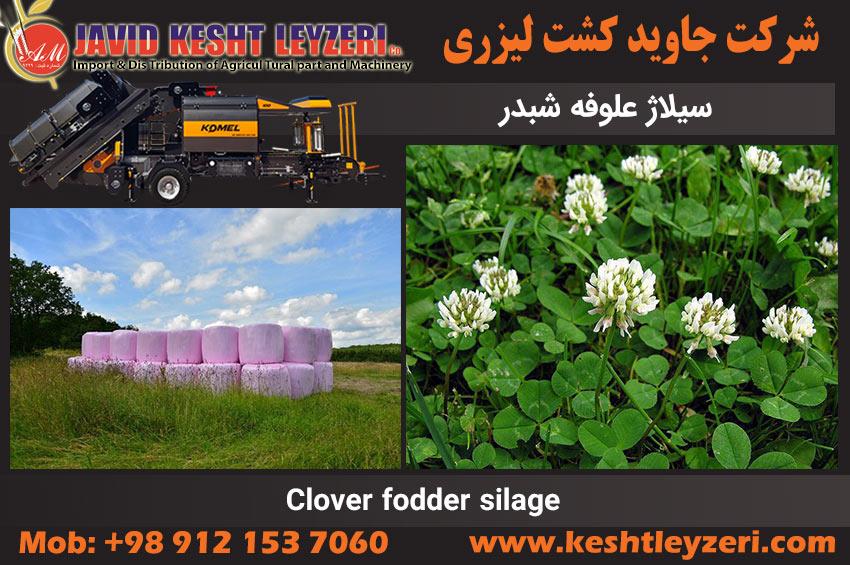
Clover fodder silage
javid keshtleyzeri Co.ltd
Trifolium clovers belong to the genus Trifolium and are among the most important forage plants of the Leguminous family in temperate and humid regions. Shamrocks are a three-leafed plant and therefore their scientific name is derived from two Latin words Tria meaning three and Folia meaning three leaves. The number of clover species in the world is about 300 species, of which 25 species are agriculturally important.
Clover is one of the perennial plants that is mostly used for animal fodder. The planting of this plant is through seeds. It grows better in temperate and humid areas.
This is a three-leafed plant. It has a high nutritional value, so it is effective in treating many diseases.
There are different types of clover. This plant is mostly used for animal fodder and feeding them.
Planting clover is done through seeds. Clover is from the fabaceae and pea family. The very small fruits of this plant have a number of small seeds that are covered in a bowl of flowers. Clover is one of the old plants that has been cultivated for a long time.
Characteristics of the clover plant:
Clover is more like hay. This forage plant has more sugar than alfalfa. The leaves of this plant are usually oval and have three leaflets. Each leaf of this plant is between 15 to 30 mm long and 8 to 15 mm wide. According to different species, it has colorful flowers such as red, purple, white and yellow, which appear densely in inflorescences. The flowers of this plant attract more bees. The leaves of this plant are attached to the stem. It has green leaves.
According to the research of Plant Gene Bank and Heritage Reserves of the Research Institute for Breeding and Preparation of Seedlings and Seeds, the number of clover species known so far in Iran is about 54 species, of which two species:
Iranian clover Trifolium resupinatum
Bersim clover Trifolium alexandrium
They are widely cultivated.
All clovers do best in cool climates. The amount of sugar in clovers is more than that of alfalfa and they have more leaf surface than alfalfa, but the resistance of clovers to salinity is less than alfalfa and the water requirement of clovers is also less than alfalfa.
Dark fodder plants of legumes are as follows in terms of root depth:
White clover root > Red clover root > Bersim clover root > Alfalfa root > Spruce root.
In general, the difference between clovers and alfalfa is that:
Alfalfa leaves are oval, but clover leaves are pear-shaped.
The color of leaves is green and clear in clover and dark green in alfalfa.
Clover is an important fodder crop. That is why it is widely used in the cultivation of pastures and pastures.
Clover as:
Green fodder
Clover fodder silage
Grass cover
used.
100 kg of fodder clover leaves contain 19.8 units and 2.7 kg of digestible protein. Clover contains more essential amino acids (cysteine, tryptophan, and leucine) than corn, barley, and wheat. In clovers, phosphorus is rarely lower than 1.44 grams per kilo of dry matter, and in this respect, they are superior to alfalfa, and animals that feed on clovers are less likely to suffer from phosphorus deficiency. True clover species with Genus Trifolium are all herbaceous and have three leaves. The flowers are many small, located on a short flower stalk. The broad outer petal is only slightly larger than the other petals. True clovers can be one-year, two-year or multi-year.
In a study conducted in 1991 by Samadi and his colleagues, the effect of Iranian clover silage processed with easy-to-digest carbohydrates and enzyme on feed intake, digestibility, chewing behavior and weight gain in sheep was done.
In this study, to investigate the effects of Iranian clover silage processing with easily digestible carbohydrates and enzyme on feed intake, digestibility, chewing behavior and weight gain in Zel sheep.
16 Mazandaran Zal male lambs were fed with completely mixed ration of TMR including 40% of dry matter, 25% of silage of clover, 15% of wheat straw and 60% of concentrate.
The experiment was conducted in a completely randomized design. Experimental rations were given to the animals in 2 doses at 7:00 am and 7:00 pm for 60 days. To determine the apparent digestibility of the rations, feed and excrement samples were collected for 5 days.
Feeding and eating activities were recorded visually for 24 hours. In order to calculate the weekly weight gain, at the end of each week, the animals were weighed individually.
The results obtained from this study showed that the highest amount of dry matter consumption, daily food consumption as optional (As fed) and the apparent digestibility of nutrients related to the treatment containing silage treated with sugar beet pomace. and the lowest amount related to treatment It contains silage material treated with enzyme (P=00420)
The highest and lowest weekly weight gain was obtained in the fourth and third week, respectively. At the end of the period, the treatment containing silage substance treated with sugar beet pomace (Treatment) 3 had the highest weight gain and the treatment containing silage substance treated with enzyme (Treatment 4) had the lowest weight gain. Similar results were observed for daily weight gain.
By improving the quality of clover silage by treating it with easily digestible carbohydrates, the time of consuming food, chewing food and the whole activity of chewing decreased, in such a way that the treatment containing silage treated with barley flour (treatment) (2) the least and the treatment containing the silage substance is the witness Treatment) 1 had the most chewing time (P=350)
In general, among the control treatments, silage containing sugar beet pomace, barley flour and enzyme had the best effect on the properties measured in the experiment, i.e., the amount of food consumed, the apparent digestibility of food, and chewing behavior. And there was an increase in the weight of the animals.
The data obtained from the experiment show that the effect of the treatment on the daily feed consumption was significant (P=0.420), so that the highest amount of dry matter consumption related to the treatment containing the silage material treated with beet pulp sugar (14.982 grams per day) and the least The amount related to the treatment contained silage material treated with enzyme (905.13 grams per day).
Similar results were obtained for daily food consumption as fed. In the silage material containing sugar beet pomace and flour, due to better fermentation and the appropriate quality of silage and palatability, livestock were more inclined to consume these silages. As a result, an increase in feed consumption was observed in these treatments compared to the control silage.
The enzyme composition added to clover silage in treatment 4 contained cellulase, hemicellulase and pectinase, which seemed to be unable to function well during the processing and fermentation stages of the silage material. Digest the cellular saw and make the intracellular contents available to the silo microorganisms. give As a result, the quality of fermentation in this silo was not desirable and its palatability was reduced, which led to a decrease in feed consumption in the experimental animals.
One of the limiting factors when feeding livestock is the optional consumption of fodder. Chemical composition and digestibility of silage matter are among the important factors in predicting voluntary intake of silage matter. Rodrigers showed that the dynamics of digestion during the first 24 hours of fermentation in the rumen is of particular importance in predicting the consumption of fodder. Another limiting factor when feeding ruminant animals is the physical limitation of their digestive system, so the beneficial chemical properties of silage may increase feed consumption.
The desired fermentation in the silage material causes an increase in the concentration of lactic acid in the silage and a decrease in the concentration of acetic acid in it, as well as a decrease in the cell wall and an increase in the digestibility of the silage material, which is All of these factors will increase the consumption of food and as a result, the performance of livestock will be improved.
The difference in the consumption amount of silage can be attributed to the difference in their fermentation rate and consequently their deliciousness.
Butler stated in a research that the concentration of ammonia nitrogen in the silage matter has a negative relationship with the amount of food consumption, and due to the fact that the concentration of ammonia nitrogen in the silage matter of clover It is less than other silage materials, it can be the reason for the improvement of dry matter consumption in lambs. And it improves performance.
The excessive concentration of acids in the silage material causes a sharp drop in pH and a decrease in the consumption of silage material. The high concentration of acetic acid in untreated silage is a determining factor in preventing the consumption of animal feed. Average daily and weekly weight gain, the effect of treatments on daily and weekly weight gain was not significant. The results show that the highest weekly weight gain was observed in the fourth week and the lowest weekly weight gain was observed in the third week.
At the end of the period, treatment three (containing silage treated with sugar beet pulp) Balatrino and treatment four (containing silage treated with enzyme) had the lowest weight gain. Due to the fact that the only variable part of the rations was the silage material and the silage material had allocated only 24 percent of the total ration to itself, and on the other hand, the silage materials in the experimental diets were similar. It was edible and the animals used it. And in choosing to put the rations in the form of TMR, it also caused some selective consumption of feed components to be prevented by the livestock, so the reasons for the significant difference in terms of weight gain between No experimental snakes were observed.
However, among the experimental diets, treatment number three (containing silage material processed with sugar beet pomace) due to more palatability of silage material and consumption of more general performance It was better than other treatments.
In diets containing low-quality fodder, adding protein supplements causes an increase in dry matter consumption, dry matter digestibility, live weight gain, milk production yield, and milk weight. It will be a flock of lambs. Clover silage, having suitable crude protein, can be used as a protein supplement in livestock feed.
Forages of the legume family, such as alfalfa and clover, have a greater consumption potential and amount of protein compared to the forages of the cereal family.
Past studies have also shown that the consumption of silage material mixed with clover and cereals leads to the improvement of performance in male lambs.
Attridge and his colleagues stated that there is a possibility that the production performance of lambs can be improved at the end of the fattening period by using diets based on leguminous silage compared to cereal silage, but Some information about the growth rate and performance of lambs fed with the substance There is silage of legumes. The difference in the amount of consumption of silage can be attributed to the difference in their fermentation rate and, accordingly, their deliciousness.
Attridge and his colleagues studied lambs fed with three types of silage: clover, alfalfa, and ryegrass and stated that lambs fed with silage of clover increased their weight by 100 grams. They showed the day and in comparison with the lambs fed with silage Hay (weight gain 50-60 grams per day) and reed grass silage (weight gain 80 grams per day) had better performance.
The above researchers attributed this difference in performance to the reason of consuming more food in diets containing clover silage. The conversion factor is 8 to 1 for lambs fed with clover silage and the conversion factor is 510 to 1 for lambs fed with ryegrass silage and for lambs fed with substance C. It was reported that the conversion factor of 1/516 for alfalfa .
These results were similar to Broderick's results. Broderick suggested that fermentable carbohydrates or non-fermentable protein is better in alfalfa silage-based diets. Added a part in the stomach to improve the performance.
The effect of the treatments on the digestibility of all nutrients in the diet was significant (P<050). The highest percentage of apparent digestibility in all nutrients is related to the treatment containing silage treated with sugar beet pulp and the lowest amount is related to the treatment containing silage treated with enzyme d.
Appropriate and desirable fermentation during ensiling increases the digestibility of the nutrients in the silage, and subsequently increases the digestibility of experimental diets containing silage. Due to the fact that in the previous experiments conducted by Samadi and Esksi, it was found that the silage material containing sugar beet pulp has the best quality in terms of appearance evaluation, characteristic Silage chemistry and rumen digestibility were among the sources of carbohydrates with fast digestibility. Accordingly, the highest nutrient digestibility was observed in treatment 3, which contained this silage substance.
Due to the fact that the components of the diet were the same except for the silage material in the experimental treatments, this difference in the digestibility of nutrients can be caused by the presence of silage material with different qualities in the diets.
If the silage has low soluble carbohydrates, the fermentable substrate is a limiting factor in the production of silage.
In this case, adding the enzyme to digest the cell wall provides the amount of substrate available for fermentation, and the problem of the lack of soluble carbohydrates increases, Nadeo et al. When they added enzyme mixture containing cellulose, hemicellulase and pectinase to alfalfa silage, it had an effect on They did not observe the amount of insoluble fiber in the neutral detergent and cell wall and cellulose compositions and stated that these results may be due to the amount of dry matter of the silage or the level of enzymes. Refusal to use.
Chewing behavior, the effect of the experimental treatments on the time of food consumption was significant, but there was no significant difference on the time of chewing and feeding activity. By improving the quality of clover silage by treating it with easy-to-digest carbohydrates, the time of consuming food, chewing food, and the whole activity of chewing decreased, so that treatment two contains silage matter. Made with the least amount of barley flour and treated with a silage substance, it has the longest chewing time. have
Due to more appropriate fermentation and more palatability in silage materials containing sugar beet pomace and barley flour, the time of food consumption was less in these test diets and there were significant differences with the control diet.
The higher the forage portion of the ration, the more desirable the quality and palatability, the less time spent feeding in TMR rations and vice versa. Since there was no difference in the experimental rations in terms of particle size, no significant difference was observed between the experimental animals in the time of feeding.
It has been shown that the whole chewing activity time consists of two parts: the time of food consumption and the time of chewing activity, and since in the tested animals, the time of food consumption is much shorter than the time of rumination. All time of chewing activity In this experiment, there was no significant difference between the treatments, although the time of food intake was significant between the experimental treatments.
The effects of the treatments on the whole time of chewing activity for one kilogram of crude protein, insoluble fiber in neutral detergent, non-fibrous carbohydrates and ash showed a significant difference, but for one kilogram of dry matter, what Raw rabi and organic matter did not have a significant effect.
The effects of the treatments did not show any significant difference on the total time of the rice per kilogram of dry matter, crude protein, insoluble fiber in neutral detergent, non-fibrous carbohydrates and organic matter, but per kilogram of soil This has a significant effect.
The effects of the treatments on the time of food consumption per kilogram of dry matter, crude protein, insoluble fiber in neutral detergent, non-fibrous carbohydrates, ash, organic matter and crude fat were significant.
In general, from the results obtained from this experiment, it can be concluded that, among the controls, barley flour and enzyme treatments, the extract containing sugar beet pomace has the best effect on the properties measured in the experiment. meaning the amount of food consumed, apparent digestibility of food, behavior Chewing and the amount of sheep weight gain.
I hope the above content will be useful, click on the image below to see the pictures of fodder packaging machines.







